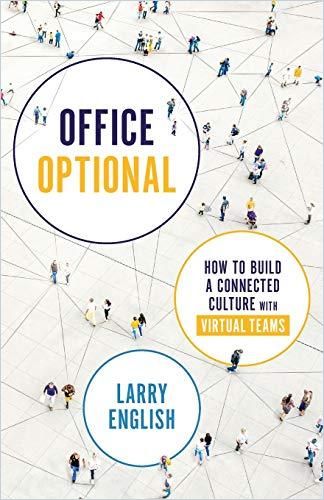“The Genie Is Out of the Bottle”

Larry, COVID-19 necessitated a shift to virtual culture, but it’s been coming for a while. In fact, your company has been virtual for 20 years or so. What’s the competitive advantage?
Larry English: One of the biggest is happier employees. When employees can work remotely, they achieve better balance in their lives – they can design their work around their life instead of the other way around. Happier employees lead to higher retention, better customer service and ultimately higher profitability. Additionally, remote employees report being more productive, thanks to a reduction in commute time and fewer interruptions than in the office.
When companies go virtual, they also save money on a reduced real estate footprint and can increase their potential candidate pool to beyond the cities they are in.
Larry English
There has been a lot of ink spilled on the downsides of remote work, such as the loss of connection or the impact on culture. In the last 20 years or so we’ve learned how to overcome these and every other challenge associated with remote work. We’ve found the benefits far outweigh any challenges.
What’s easy and what’s more challenging about sharing culture in remote teams? What might get lost in the transition to remote?
When your employees aren’t coming to a physical office every day, some of the big indicators of culture aren’t visible – how people interact in the office, what the office looks like and how people dress, to name just a few examples. To overcome this, you need to figure out ways to train employees in your culture. When new hires join Centric, they go through a day-and-a-half culture training led by company leaders. We share stories and take them through fun activities and interactions to teach them how to live our culture. We’ve also changed how we operate remotely so we’re constantly reinforcing our culture. For instance, we start our virtual meetings with a virtual watercooler where we take time to connect on a personal level. Sometimes we use the time to share a story of someone who is living our culture. We’ve also developed a tool to inventory and highlight stories of employees living our core purpose (e.g., taking care of a client by providing an unmatched experience).

You say cultural fit is as important as skill in new hires. How should employers think about that? What kinds of questions should they ask? How do you make sure there is a cultural fit?
If you value having a strong culture, you need to spend time in the interview process to ensure employees are a match. During interviews, we spend half the time evaluating skills and half whether they match our culture. Of course, some elements of your culture can be taught, while others are more innate qualities. We’ve broken our culture into these two categories – for example, we know we can teach a new hire how to innovate, but it would be difficult if not impossible to teach someone to be kind or have integrity. If the candidate doesn’t have those innate qualities, we don’t hire them. The real test is when a candidate is a rainmaker but doesn’t match your culture – the second you start to compromise, it’s a slippery slope for your culture.
In Office Optional, you emphasize collaboration tools for remote teams. What should employers look for when evaluating what’s out there?
Before introducing another tool, companies should do an inventory of the solutions and tools they’re already invested in. Most have deployed overlapping solutions that can cause confusion among users. They also need to consider how the collaboration tool will integrate with what employees already use daily. Introducing another “tool” that doesn’t look, feel or work like anything else typically ends up in failure. When selecting a tool, the top priority should be information security and protection of the application itself, and the level and type of security should be customizable to the organization’s needs. Large companies in highly regulated industries, for example, may require significant security mechanisms that aren’t necessary for smaller companies. Companies should also look for collaboration tools that are simple to use yet feature-rich and easily integrated with other applications:
You don’t want remote workers to have to use numerous applications in their daily work.
Larry English
Finally, given the mobility of remote workers, collaboration tools should be easy to use from anywhere and from any device.

What’s your number one tip for being a good remote employee?
Bring your whole self to work – take time to share your personality and get to know your teammates. By letting your co-workers get to know you and what makes you tick, you’ll develop closer and better virtual relationships, which not only will make you a happier remote worker but will also facilitate virtual collaboration. It’s also important that remote workers overcommunicate. Putting yourself out there by sharing ideas and reaching out to people will make you more effective.
With the pandemic – hopefully – winding down, we’re hearing a lot about the “hybrid” workplace. Will the trend to remote continue to grow? Or do you think there’ll be a rebound effect once people can go back to “business as usual?” What does the “hybrid” workplace look like in 10 or so years? Will there still be corporate campuses, or will businesses become more decentralized?
The genie is out of the bottle. Even the most conservative companies are announcing they are adopting a hybrid model. Almost no one wants to go back to the office five days a week forever, and we’re already seeing employees look for another job when forced back. To attract and retain the best talent, companies don’t have a choice – they’ll have to offer remote work at least some of the time. There are also too many advantages for companies to pass up, from saving on real estate to expanding the labor pool. I suspect the hybrid trend will play out the way it has for my company: We are so comfortable with remote work (it has become second nature) and there are so many benefits that we just don’t need an office as much. I think you will eventually see more decentralized business with their infrastructure in the cloud, hiring employees from anywhere and needing less real estate.
About the Author
Larry English is the co-founder and president of the management and consulting firm, Centric Consulting, and author of Office Optional.






